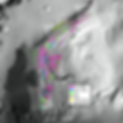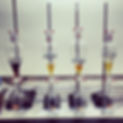
Research
My research is focused on water-rock interaction as recorded in a body's near-surface environment. I use both experimental methods (laboratory and analogue studies) and observational methods (rover and orbital data analysis) to quantitatively address geologic questions on Earth, Mars, asteroids, and other rocky and icy bodies. Descriptions of my past and ongoing projects can be found below.
Phosphate geochemistry
2024-present
I am collecting detailed chemical, mineralogical, and Vis-NIR-MIR spectral data of a wide variety of natural and synthetic phosphates to understand the details of phosphate spectral features being found on Mars and within asteroids.


Spectral heterogeneity in rubble pile asteroids
2022-present
I am part of the MicrOmega team that spans IAS (Orsay, France) and ISAS/JAXA (Sagamihara, Japan) studying samples returned from rubble pile asteroids Bennu and Ryugu. I am particularly interested in spectral variation at multiple spatial scales, from between sampling sites to within a single grain.
Continuous flow experiments to constrain martian groundwater conditions
2021-present
We are using continuous flow laboratory experiments to constrain the details of chemical reactions occurring during water-rock interaction. We have found that Li can be pulled out of groundwater by specific clay minerals, a hypothesis proposed by members of the Curiosity rover ChemCam team based on observations in Gale crater.


Spectral masking: when one phase can obscure another
2019-present
I am interested in how certain surface minerals can obscure the spectral evidence of others. Using spectrometers with atmospheric chambers, I have studied how quickly minerals can uptake and lose water from their crystal structure. Notably, I found that the spectral evidence of dehydrated Mg sulfates is easily obscured if clay minerals are present in the same sample (Sheppard et al., 2020) and that the presence of Mg sulfates can in turn obscure evidence of carbonates.
Mineralogy and stratigraphy of Mt. Sharp
2018-present
I mapped the mineral stratigraphy of Mt. Sharp beyond the Curiosity rover traverse to understand how mineralogy changes across morphological contacts. These stratigraphic relationships and how they vary laterally can help constrain the crater's history, both during its lacustrine phase and long after. I am continuing this work by documenting diagenetic fluid events superimposed on the primary mineral stratigraphy.


Lake Towuti: a terrestrial analogue for Lake Gale?
2015-2018
Lake Towuti is a redox-stratified lake in ultramafic bedrock in Indonesia. This provides a rare opportunity to test the hypothesis that the ancient martian lake in Gale crater was redox-stratified. I characterized the crystalline and amorphous mineralogy of the catchment, lake basin, and a 100 m long drill core to understand what signals can be uniquely linked to lake conditions. I found that amorphous Fe-rich phases are created rapidly in the water column, and that they persist in ~1 million year old sediment, two observations also seen in Gale sediment. Towuti provides an interesting analogue that is complementary to many other cold-weather and basaltic Mars analogues because of its complex amorphous Fe history.
Diamond color origin using FTIR and Raman spectroscopy
2013-2015
Spectroscopy is a main tool to investigate whether diamonds are natural, lab-grown, and/or have had their color enhanced. My expertise at the Gemological Institute of America was in spectral analysis of very small gems, or melee. I developed new analytical techniques for quickly determining the mineralogy and color origin of melee using FTIR spectroscopy, publishing results and methods in Gems & Gemology.


Biomarkers and rapid heating experiments
2011-2014
Methylphenanthrenes are organic molecules that can be used as a paleothermometer to understand past fault slip rates. We calibrated this technique using fault samples with pseudotachylite, a visible record of the most intensely heated part of the rock. To understand the kinetics of these reactions we also conducted rapid heating experiments to see how the molecules broke down under different time and temperature regimes.